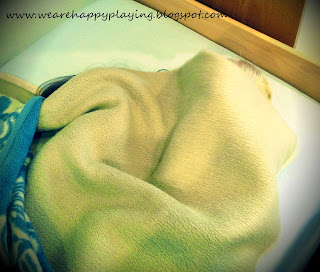 A while ago I posted a tutorial (here) on how to sew a giant scrunchie which could be used for the classic schoolyard game Elastics. In our household the gigantic scrunchie, which is also otherwise known as a co-operation band in the educational and sport's sector, has been used for more than just Elastics. In an earlier post (here),I showed how the children used it to play 'horse and carriage' as well as an obstacle to jump and tumble over.
A while ago I posted a tutorial (here) on how to sew a giant scrunchie which could be used for the classic schoolyard game Elastics. In our household the gigantic scrunchie, which is also otherwise known as a co-operation band in the educational and sport's sector, has been used for more than just Elastics. In an earlier post (here),I showed how the children used it to play 'horse and carriage' as well as an obstacle to jump and tumble over. Today I want to share with you another way we've been using our gigantic scrunchie. With this beautiful sunny weather we've been having in Germany, we've taken the scrunchie back outside to use it as a tool for making and exploring shapes. With just my daughter and I playing, we we're able to make squares, rectangles and a range of polygons. In order to see what shape we had made we looked at the shadows we casted on the lawns.
I really liked using the scrunchie for making polygons. This also lead to a chat between my daughter and I about how we can find out the name of some shapes by counting how many sides they have. I also explained that if she could count to 10 in Greek it would be easy for her to work out the name of these shapes as they relate to the names of the Greek numbers.
For those of you who are interested, numbers 1 to 10 in Greek are...
 |
| Image from http://gogreece.about.com/od/greeklanguage/a/learn_to_count_in_greek.htm?utm_source=pinterest&utm_medium=social&utm_campaign=shareurlbuttons_nip |
Here we are attempting to make a hexagon. Unfortunately it was sometimes a bit tricky to get the shape just right but we could still count the sides and name the shape.
This was our attempt at a pentagon. We achieved 5 sides but not the typical pentagon shape we are so used to. My head kept getting in the way!
I can imagine this would be a great activity with more kids. Each child could create a corner and position themselves to make more regular shapes. With more children you could also attempt more complicated polygons and try to work out their names. You could learn to count beyond 10 in Greek to see how similar the names are to the Greek numbers.
Doing it in this fashion the shape would not cast a shadow before the children but underneath the shape. You would have to look at the shape from above to see what it was. Here is an example of my little monkey and her cousins making a triangle. As you can see there is still a shadow but just from underneath.
Well there you have it! Who would have thought I'd be posting about giant scrunchies, polygons and Greek numbers all in the same post? I sure as pie didn't see it coming.
Well until next time, happy learning and happy playing.






















































